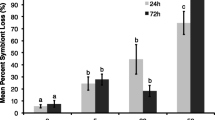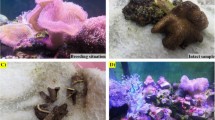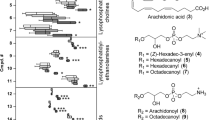Abstract
Irgarol 1051 is an s-triazine herbicide formulated with Cu2O in antifouling paints. Recent studies have shown that Irgarol 1051 inhibits coral photosynthesis at environmentally relevant concentrations, consistent with its mode of action as a photosystem II inhibitor. Related toxicologic effects of this herbicide on coral cellular physiology have not yet been investigated. We used cellular diagnostics to measure changes in 18 toxicologic cellular parameters in endosymbiotic algal (dinoflagellate) and cnidarian (host) fractions of the common branching coral Madracis mirabilis associated with in vivo 8- and 24-hour exposures to a nominal initial Irgarol 1051 concentration of 10 μg L−1. Responses measured were (1) xenobiotic response, which includes total and dinoflagellate multixenobiotic resistance (MXR), cnidarian cytochrome (CYP) P450−3 and P450-6 classes, cnidarian, and dinoflagellate glutathione-s-transferase (GST); (b) oxidative damage and response, which includes cnidarian and dinoflagellate Cu/Zn and Mn superoxide dismutase (SOD), cnidarian and dinoflagellate glutathione peroxidase (GPx), cnidarian catalase, and total protein carbonyl); (3) metabolic homeostasis, which includes chloroplast and invertebrate small heat-shock proteins (sHsp), cnidarian protoporphyrinogen oxidase IX (PPO), cnidarian ferrochelatase, and cnidarian heme oxygenase; and (4) protein metabolic condition, which includes cnidarian and dinoflagellate heat shock proteins (hsp70 and hsp60), total ubiquitin, and cnidarian ubiquitin ligase. Acute responses to Irgarol 1051 exposure included significant increases in total and dinoflagellate MXR, dinoflagellate Cu/Zn SOD, dinoflagellate chloroplast sHsp, and cnidarian PPO. Irgarol 1051 exposure resulted in decreases in cnidarian GPx, cnidarian ferrochelatase, cnidarian catalase, and cnidarian CYP 450-3 and -6 classes. Related implications of Irgarol 1051 exposure to coral cellular condition are discussed.









Similar content being viewed by others
References
Abel EL, Opp SM, Verlinde CL, Bammler TK, Eaton DL (2004), Characterization of atrazine biotransformation by human and murine glutathione s-transferases. Toxicol Sci 80:230–238
Adams J (2004) The development of proteasome inhibitors as anticancer drugs. Cancer Cell 5:417–421
Arrigo A, Pauli D (1998) Characterization of hsp27 and three immunologically related polypeptides during Drosophila development. Exp Cell Res 175:169–183
Basha E, Lee GJ, Demeler B, Vierling E (2004) Chaperone activity of cytosolic small heat shock proteins from wheat. Eur J Biochem 271:1426–1436
Basheer C, Tan KS, Lee HK (2002) Organotin and Irgarol 1051 contamination in Singapore coastal waters. Mar Poll Bull 44:697–703
Berleth ES, Pickart CM (1996) Mechanism of ubiquitin conjugating enzyme E2-230K: Catalysis involving thiol relay? Biochemistry 35:1664–1671
Bonassi S, Au WW (2002) Biomarkers in molecular epidemiology studies for health risk prediction. Mutat Res 511:73–86
Bonassi S, Neri M, Puntoni R (2001) Validation of biomarkers as early predictors of disease. Mutat Res 480–481:349–358
Brown B, Downs CA, Dunne RP, Gibb SW (2002a) Exploring the basis of thermotolerance in the reef coral Goniastrea aspera. Mar Ecol Prog Ser 242:119–129
Brown BA, Downs CA, Dunne RP, Gibb SW (2002b) Preliminary evidence for tissue retraction as a factor in photoprotection of corals incapable of xanthophyll cycling. J Exp Mar Biol Ecol 277:129–144
Chelikani P, Fita I, Loewen PC (2004) Diversity of structures and properties among catalases. Cell Mol Life Sci 61:192–208
Crampton AL, Baxter GD, Barker SC (1999) A new family of cytochrome P450 genes (CYP41) from the cattle tick, Boophilus microplus. Biochem Mol Biol 29:829–834
Crowther JR (2001). The ELISA guidebook. Totowa, NJ, Humana
Dahl B, Blanck H (1996) Toxic effects of the antifouling agent Irgarol 1051 on periphyton communities in coastal microcosms. Mar Pollut Bull 32:342–350
Dailey HA, Dailey TA, Wu C-K, Medlock AE, Wang K-F, Rose JP, et al. (2000) Ferrochelatase at the millennium: Structures, mechanisms and [2Fe-2S] clusters. Cell Mol Life Sci 57:1909–1926
Ding Q, Dimayuga E, Martin S, Bruce-Keller AJ, Nukala V, Cuervo AM, et al. (2003) Characterization of chronic low-level proteasome inhibition on neural homeostasis. Neurochemistry 86:489–497
Dixon DP, Lapthorn A, Edwards R (2002) Plant glutathione transferases. Genome Biol 3:1–10
Downs CA (2005) Cellular diagnostics and its application to aquatic and marine toxicology. In: Ostrander G (ed) Techniques in aquatic toxicology. Volume 2. Boca Raton, FL, CRC Press, pp 181–207
Downs CA, Fauth JE, Halas JC, Dustan P, Bemiss J, Woodley CM (2002) Oxidative stress and seasonal coral bleaching. Free Radic Biol Med 33:533–543
Downs CA, Mueller E, Phillips S, Fauth JE, Woodley CM (2000) A molecular biomarker system for assessing the health of coral during heat stress. Mar Biotechnol 2:533–544
Downs CA, Ryan SL, Heckathorn SA (1999a) The chloroplast small heat-shock protein: Evidence for a general role in protecting photosystem II against oxidative stress and photoinhibition. J Plant Physiol 155:488–496
Downs CA, Coleman JS, Heckathorn SA, (1999b) The chloroplast 22-kDa heat-shock protein: A lumenal protein that associates with the oxygen evolving complex and protects photosystem II during heat stress. J. Plant Physiol 155:477–487
Guach HGJ (1985) Multivariate analysis in community ecology. New York, NY, Cambridge University Press
Ghosh S, Gepstein S, Heikkila JJ, Dumbroff BG (1988) Use of a scanning densitometer or an ELISA plate reader for measurement of nanogram amounts of protein in crude extracts from biological tissue. Anal Biochem 169:227–233
Haeger-Aronsen B (1964) Experimental disturbance of porphyrin metabolism and of liver catalase activity in guinea pigs and rabbits. Acta Pharmacol Toxicol 21:105–115
Hall LW Jr, Giddings JM, Solomon KR, Balcomb R (1999) An ecological risk assessment for the use of Irgarol 1051 as an algaecide for antifoulant paints. Crit Rev Toxicol 29:367–437
Hall LW Jr, Killen WD, Gardinali PR (2004) Occurrence of Irgarol 1051 and its major metabolite in Maryland waters of Chesapeake Bay. Mar Pollut Bull 48:554–562
Halliwell B, Gutteridge JMC (1999) Free radicals in biology and medicine, 3rd ed. Oxford, UK, Oxford Science
Hanioka N, Jinno H, Tanaka-Kagawa T, Nishimura T, Ando M (1999) In vitro metabolism of chlorotriazines: Characterization of simazine, atrazine, and propazine metabolism using liver microsomes from rats treated with various cytochrome P450 inducers. Toxicol Appl Pharmacol 156:195–205
Heckathorn SA, Downs CA, Coleman JS (1999) Small heat-shock proteins protect electron transport in chloroplasts and mitochondria during stress. Am Zool 39:865–876
Heckathorn SA, Downs CA, Sharkey TD, Coleman JS (1998) The small methionine-rich chloroplast heat-shock protein protects photosystem II electron transport during heat stress. Plant Physiol 116:439–444
Hershko A, Heller H, Eytan E, Reiss Y (1986) The protein substrate binding site of the ubiquitin-protein ligase system. J Biol Chem 261:11992–11999
Jones RJ, Kerswell AP (2003) Phytotoxicity evaluation of Photosystem II (PSII) herbicides on scleratinian coral. Mar Ecol Prog Ser 261:149–159
Ketter B (2001) A bird’s eye view of the glutathione transferase field. Chem Biol Interact 138:27–42
Konstantinou IK, Albanis TA (2004) Worldwide occurrence and effects of antifouling paint booster biocides in the aquatic environment: a review. Environ Int 30:235–248
Lewis DF (2004) 57 varieties: The human cytochromes P450. Pharmacogenomics 5:305–318
Lledias F, Rangel P, Hansberg W (1998) Oxidation of catalase by singlet oxygen. J Biol Chem 273:10630–10637
Liu N, Scott JG (1998) Increased transcription of CYP6D1 causes cytochrome P450-mediated insecticide resistance in house fly. Insect Biochem Mol Biol 28:531–535
Marks GS, Zelt DT, Cole SPC (1982) Alteration in the heme biosynthetic pathway as an index of exposure to toxins. Can J Physiol Pharmacol 60:1017–1026
Marks GS (1985) exposure to toxic agents: The heme biosynthetic pathway and the hemoproteins as indicators. Crit Rev Toxicol 15:151–179
Martinoia E, Klein M, Geisler M, Bovet L, Forestier C, Kolukisaoglu U, et al. (2002) Multifunctionality of plant ABC transporters—More than just detoxifiers. Planta 214:345–355
Michaud S, Marin R, Tanguay RR (1997) Regulation of heat shock gene induction and expression during Drosophila development. Cell Mol Life Sci 53:104–113
Morrow G, Samson M, Michaud S, Tanguay RM (2004) Overexpression of the small mitochondrial Hsp22 extends Drosophila life span and increases resistance to oxidative stress. FASEB J 18:598–589
Owen R, Knap AH, Toaspern M, Carbery K (2002) Inhibition of coral photosynthesis by the antifouling herbicide Irgarol 1051. Mar Pollut Bull 44:623–632
Owen R, Knap AH, Ostrander N, Carbery K (2003) Comparative acute toxicity of herbicides to photosynthesis of coral dinoflagellate. Bull Environ Contam Toxicol 70:541–548
Parkes TL, Hilliker AJ, Phillips JP (1993) Genetic and biochemical analysis of glutathione-s-transferase in the oxygen defense system of Drosophila melanogaster. Genome 36:1007–1014
Perera FP (2000) Molecular epidemiology: On the pathway to prevention? J Natl Cancer Inst 92:602–612
Ranson H, Claudianos C, Ortelli F, Abgrall C, Hemingway J, Sharakhova MV, et al. (2002) Evolution of supergene families associated with insecticide resistance. Science 298:179–181
Raza H, Robin M, Fang J, Avadhani NG (2002) Multiple isoforms of mitochondrial glutathione-s-transferases and their differential induction under oxidative stress. Biochem J 366:45–55
Raynor C (1999) Advances in sulfur chemistry. Volume 2. Oxford, UK, Elsevier Science
Readman JW, Wee Knong LL, Grondin D, Barocci J, Villeneuve LP, Mee LD (1993) Coastal water contamination from a triazine herbicide used in antifouling paints. Environ Sci Technol 17:553–556
Sauna ZE, Smith MM, Muller M, Kerr KM, Ambudkar SV (2001) The mechanism of action of multidrug-resistance-linked P-glycoprotein. J Bioenerg Biomembr 33:481–491
Schwartzburd PM (2001) Self-cytoprotection against stress: Feedback regulation of heme dependent metabolism. Cell Stress Chaperones 6:1–5
Shimizu N, Kobayaski K, Hayashi K (1984) The reaction of superoxide radical with catalase: Mechanism of the inhibition of catalase by superoxide. J Biol Chem 259:4414–4418
Sokal RR, Rohlf FJ (1995) Biometry. New York, NY, Freeman
Stonard MD, Poli G, Matteis FS, (1998) Stimulation of liver heme oxygenasein hexachlorobenzene-induced hepatic porphyria. Arch Toxicol 72:355–361
Sun W, Van Montagu M, Verbruggen N (2002) Small heat shock proteins and stress tolerance in plants. Biochim Biophys Acta 21577:1–9
Teschke R., Boelsen, Landmann H, Goerz G (1983) Effect of hexachlorobenzene on the activities of hepatic alcohol metabolizing enzymes. Biochem Pharmacol 32:1745–1751
Thomas KV (2001) The environmental fate and behaviour of antifouling paint—Booster biocides: A review. Biofouling 17:73–86
Thunell S (2000) Porphyrins, porphyrin metabolism and porphyries. I. Update Scand J Clin Lab Invest 60:509–540
Thunell S, Harper P (2000) Porphyrins, porphyrin metabolism, porphyries. III. Diagnosis, care, and monitoring in porphyria cutanea tarda—Suggestions for a handling programme. Scand J Clin Lab Invest 60:561–580
Wu G, Wilen RW, Robertson AJ, Gusta LV (1999) Isolation, chromosomal localization, and differential expression of mitochondrial manganese superoxide dismutase and chloroplastic copper/zinc superoxide dismutase genes in wheat. Plant Physiol 120:513–520
Acknowledgments
This work was funded by EnVirtue Biotechnologies, Inc, and the Department of Environmental Protection, Bermuda Government. We thank Richard Owen and Lucy Buxton for their help in setting up the experiments in Bermuda. We also thank the two anonymous reviewers for their careful editing and improvements to the manuscript.
Author information
Authors and Affiliations
Corresponding author
Rights and permissions
About this article
Cite this article
Downs, C., Downs, A. Preliminary Examination of Short-Term Cellular Toxicological Responses of the Coral Madracis mirabilis to Acute Irgarol 1051 Exposure. Arch Environ Contam Toxicol 52, 47–57 (2007). https://doi.org/10.1007/s00244-005-0213-6
Received:
Accepted:
Published:
Issue Date:
DOI: https://doi.org/10.1007/s00244-005-0213-6




